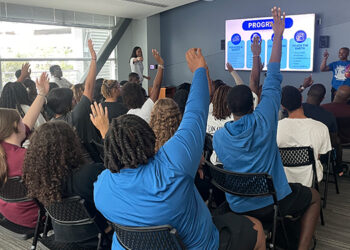When deciding how to best put a creative spin on its end of the year report, North Carolina Central University (NCCU) Recreation and Wellness decided to make its first ever storyboard for the department.
According to James Leach, the associate director of NCCU Campus Recreation, the idea was inspired by Towson University’s storyboard which Tiffany Lomax, the director of NCCU Recreation and Wellness, was introduced to a few years ago. She was then able to utilize the concept during her tenure at Colby College.
“Though we were inspired by their storyboard, we were intentional about not trying to duplicate their story,” said Leach. “We used our experiences to paint a picture that reflects how we impacted the Eagle community. Understanding and respecting the differences in our institution, our program and our community was paramount.”
However, the department faced limitations due to the size of the university, budget and staff, along with a lack of resources on hand. But that didn’t stop NCCU Recreation and Wellness from creating a showcase that made them standout from other departments at the school.
Overcoming Obstacles
Where many schools have a dedicated marketing team with student staff, Princess Jackson, the Community Engagement coordinator, was the only person actively designing the storyboard. While she said crafting the 10 pages took a lot of energy out of her, the support of her team carried her through the experience.
“I leaned on them when I got stuck, and they were able to serve up a new perspective that would jumpstart my creative flow,” said Jackson. “For example, we held a brainstorming session for the title of the storyboard, On the Rise. We ultimately went with the name developed by Alicia Benson, our Wellness and Outdoor Programs coordinator, and that helped inform the overall voice of the report.”
Lomax said due to the limitations in the number of staff members and the multitude of their responsibilities, Jackson is also the department’s photographer, videographer, graphic designer and social media manager while also overseeing memberships and community outreach.
Another limitation in the process was compiling data to complete the “Let the Numbers Talk” section of the storyboard. Leach said they do not have recreation management software that generates reports. Therefore, the team manually tabulated the numbers from Excel Spreadsheets.
Branding Strategies
Jackson said giving the storyboard its own voice unique to NCCU was a huge focus in the project. She said she drew a lot of inspiration from the self-confidence and bravado found in childhood while growing up and playing sports.
“That freedom of expression and self is refreshing and invigorating,” said Jackson. “With this storyboard, I wanted to assert not only are we proud of the impact we’ve made so far, but we also have the energy and enthusiasm to do something bigger. We’re the only department on campus that produced something like this, so all eyes are on us now. We’re not afraid of the challenge.”
For the design, Jackson said she wanted to emphasize the experiences the department offers which cannot just be boiled down to the number of participants. That’s why the standout element on most of the pages are cutouts of students, faculty and staff immersed in various activities.
“From the title and page headings to the selection of images and creation of copy, everything had to be intentional and cohesive,” Jackson said. “And that takes a lot of work and attention to detail.”
Storyboard Benefits for Smaller Schools
No matter the size of the student body or participation numbers, Jackson said a storyboard can be an effective way to showcase the influence campus recreation has on a community.
“Numbers only tell one part of the story and for historically Black colleges and universities (HBCUs) or smaller institution’s recreation programs, that can be misleading,” said Jackson. “When we lean too much into the numbers and not how programming makes the community feel, whether giving a sense of belonging or increasing one’s well-being, disappointing decisions are made. Storyboards are less about the numbers and more about the people. While HBCUs or smaller institutions may not have endless staff members or budgets, a storyboard can showcase the impact recreation departments have on their campus.”
For Lomax, having that perspective is essential in demonstrating the power her department has at NCCU.
“The storyboard allows us to showcase all we have accomplished and overcome” said Lomax. “We hope this storyboard inspires other institutions, but one thing we noticed in the process was how it inspired our team to be more and do more. Everyone wants their program and/or accomplishments highlighted in the next storyboard.”
Want more updates and information on how to effectively showcase your recreation department no matter the size of your university? Sign up for a digital subscription here.










